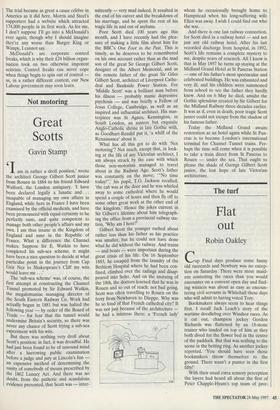Not motoring
Great Scotts
Gavin Stamp
Iam in rather a droll position,' wrote the architect George Gilbert Scott junior from Rouen in 1884 to his friend Edward Walford, the London antiquary. 'I have been declared legally a lunatic and . . . incapable of managing my own affairs in England, while here in France I have been examined by the official medicals, and have been pronounced with equal certainty to be perfectly sane, and quite competent to manage both other people's affairs and my own. I am thus insane in the Kingdom of England and sane in the Republic of France. What a difference the Channel makes. Suppose Sir E. Watkin to have completed his sub-sea scheme, it might have been a nice question to decide at what particular point in the journey from Cap Griz Nez to Shakespeare's Cliff my wits would leave me . . .'
The `sub-sea scheme' was, of course, the first attempt at constructing the Channel Tunnel promoted by Sir Edward Waticin, the megalomaniac managing director of the South Eastern Railway Co. Work had actually begun in 1881 but was halted the following year — by order of the Board of Trade — for fear that the tunnel would undermine Britain's security, so there was never any chance of Scott trying a sub-sea experiment with his wits.
But there was nothing very droll about Scott's position; in fact, it was dreadful. He had just been found to be of unsound mind after a harrowing public examination before a judge and jury at Lincoln's Inn — an expensive method of determining the sanity of somebody of means prescribed by the 1862 Lunacy Act. And there was no doubt, from the pathetic and scandalous evidence presented, that Scott was — inter- mittently — very mad indeed. It resulted in the end of his career and the breakdown of his marriage, and he spent the rest of his tragic life in and out of asylums.
Poor Scott died 100 years ago this month, and I have recently had the plea- sure of making a little film about him for the BBC's One Foot in the Past. This is timely, as he deserves to be remembered on his own account rather than as the mad son of the great Sir George Gilbert Scott, designer of the Albert Memorial, and as the remote father of the great Sir Giles Gilbert Scott, architect of Liverpool Cathe- dral and Bankside Power Station. For 'Middle Scott' was a brilliant man before his illness — probably manic depressive psychosis — and was briefly a Fellow of Jesus College, Cambridge, as well as an inspired and influential architect. His mas- terpiece was St Agnes, Kennington, in South London, an austere but exquisite Anglo-Catholic shrine in late Gothic with, as Goodhart-Rendel put it, 'a whiff of the Renaissance' about it.
What has all this got to do with 'Not motoring'? Not much, except that, in look- ing at the life of any Victorian architect, I am always struck by the ease with which those non-motorists managed to travel about in the Railway Age. Scott's father was constantly on the move; "No time today!",' his pupil, T.G. Jackson recalled; 'the cab was at the door and he was whirled away to some cathedral where he would spend a couple of hours and then fly off to some other great work at the other end of the kingdom.' Hence the jokes current in Sir Gilbert's lifetime about him telegraph- ing the office from a provincial railway sta- tion, 'Why am I here?' Gilbert Scott the younger rushed about rather less than his father as his practice was smaller, but he could not have done what he did without the railway. And trains — and boats — were important during the great crisis of his life. On 16 September 1883, he escaped from the laundry of the Bethlem Hospital where he had been con- fined, climbed over the railings and disap- peared into Soho. And on the morning of the 18th, the doctors learned that he was in Rouen and so out of reach: not bad going. Scott was often travelling to Rouen on the ferry from Newhaven to Dieppe. Why was he so fond of that French cathedral city? It was not just because of the architecture — he had a mistress there: a 'French lady' whom he occasionally brought home to Hampstead when his long-suffering wife Ellen was away. I wish I could find out who she was.
And there is one last railway connection, for Scott died in a railway hotel — and not just any old railway hotel. After his last recorded discharge from hospital, in 1892, Scott's life remains a complete mystery to me, despite years of research. All I know is that in May 1897 he turns up staying at the Midland Grand Hotel at St Pancras Station — one of his father's most spectacular and celebrated buildings. He was exhausted and very ill, and his children were summoned from school to see the father they hardly knew. And on 6 May he died, amidst the Gothic splendour created by Sir Gilbert for the Midland Railway three decades earlier. It was as if, even in death, poor tragic Scott junior could not escape from the shadow of his famous father.
Today the Midland Grand awaits restoration as an hotel again while St Pan- cras is to become London's international terminal for Channel Tunnel trains. Per- haps the time will come when it is possible to take a train direct from St Pancras to Rouen — under the sea. That ought to please the shade of George Gilbert Scott junior, the lost hope of late Victorian architecture.


























































 Previous page
Previous page